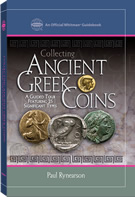
PREV ARTICLE
NEXT ARTICLE
FULL ISSUE
PREV FULL ISSUE
BOOK REVIEW: COLLECTING ANCIENT GREEK COINS BY PAUL RYNEARSON
With permission, Dennis Tucker of Whitman Publications forwarded these notes on Rynearson's Collecting Ancient Greek Coins by
Michael T. Shutterly, who had emailed them in. Michael is now one of our newest subscribers.
-Editor
There are four general types of books in this area available to collectors: (1) basic price catalogs, the most notable example probably being Sear's two-volume Greek Coins and Their Values; (2) ‘pretty picture' books, such as Berk's The Hundred Greatest Ancient Coins (which you publish); (3) scholarly studies in particular series, such as Lorber's Amphipolis - Civic Coinage in Silver and Gold; and (4) collection catalogs, such as The Arthur S. Dewing Collection of Greek Coins (edited by Mildenberg and Hurter), and of course the entire Catalogue of the Greek Coins in the British Museum. Dr. Rynearson's book does not replace any of them (and does not purport to), but it provides enough of the elements of each of them to be entirely satisfying by itself. The book provides a wealth of information that is almost critically necessary for the beginning or intermediate collector, and yet much of it is not available in any single source — except in this book. And even the most advanced collector— who may already knows all of the ‘facts' in the book— can appreciate the book for its grace, style, and aesthetic commentary. One masterstroke (among many) is in Dr. Rynearson's suggestions for putting together a much-better-than-basic collection of Greek coins: he identifies and describes a very well-thought out program whereby a collector— who perhaps admires but does not possess the wealth of Kroisos — could, over time, assemble a wonderful collection that would present enjoyable challenges, while fully satisfying his or her interests in the aesthetics, culture and history of the time. The production values of the book are satisfying as well. The illustrations are superb, and they do ample justice to the quality of the coins they depict. I do have two nits to pick, and I suspect that neither of these is the fault of Dr. Rynearson. The Preface includes a picture of a ‘stater' (I prefer ‘nomos') of Metapontum— the archaic version of which, appearing in chapter 3 of Part II, is one of my favorite coins, brilliant in its stark simplicity— and the accompanying description notes that the coin depicts ‘an ear of corn.' I suspect that one of your editors found that reference in a British catalogue, and while it is a common description, alas, it is one that could be somewhat confusing to an American reader, for whom ‘ear of coin' means something that no one in ‘Metapontum' would ever have seen: for us in the US, ‘corn' means maize, a specific grain cultivated in the New World and not introduced into Europe until more than 18 centuries after this coin was minted, whereas in Britain, ‘corn' means the edible seed of whatever grain happens to be locally available (wheat in England, oats in Scotland, and, as it happens, barley in ‘Metapontum'). When the next edition of the book comes out, I would respectfully request that you revise the Preface to refer to the grain as an ‘ear of grain' (as Dr. Rynearson does, on p. 119) or an ‘ear of barley' or, if you absolutely insist on using the word ‘corn,' then call it a ‘barleycorn,' but please, not ‘ear of corn.' My other nit, also related to something in the Preface, is that you used the Latin form of the names of the coin-issuing sites: instead of ‘Metapontum' and ‘Tarentum,' you should be using the (more accurate) Greek ‘Metapontion' and ‘Taras' (as Dr. Rynearson does, consistently, elsewhere in the book). The only other request I would make is that you commission Dr. Rynearson to prepare a companion volume, Collecting Ancient Roman Coins. The field of Roman coins has the same need for such a book as the field of Greek coins had— until Dr. Rynearson filled it so well. Thank you for making this wonderful book available to the public. Dennis Tucker adds: Thank you so much for sharing your thoughts on Paul Rynearson's Collecting Ancient Greek Coins! It's always nice to hear from appreciative readers. The preface was Whitman's, not Dr. Rynearson's, and it drew from Klawans, which explains the inconsistencies with Rynearson's main text. Excellent observations, and we'll make the changes you've recommended in the 2nd edition. Wayne Homren, Editor The Numismatic Bibliomania Society is a non-profit organization promoting numismatic literature. See our web site at coinbooks.org. To submit items for publication in The E-Sylum, write to the Editor at this address: whomren@gmail.com To subscribe go to: https://my.binhost.com/lists/listinfo/esylum All Rights Reserved. NBS Home Page Contact the NBS webmaster 
|
